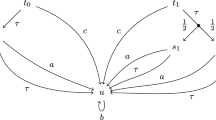Abstract
We take a fresh look at strong probabilistic bisimulations for processes which exhibit both non-deterministic and probabilistic behaviour. We suggest that it is natural to interpret such processes as distributions over states in a probabilistic labelled transition system, a pLTS; this enables us to adapt the standard notion of contextual equivalence to this setting. We then prove that a novel form of bisimulation equivalence between distributions are both sound and complete with respect to this contextual equivalence. We also show that a very simple extension to HML, Hennessy–Milner Logic, provides finite explanations for inequivalences between distributions. Finally we show that our bisimulations between distributions in a pLTS are simply an alternative characterisation of a standard notion of probabilistic bisimulation equivalence, defined between states in a pLTS.
Similar content being viewed by others
References
Andova S (2002) Probabilistic process algebra. PhD thesis, Eindhoven University of Technology
Baier C, Engelen B, Majster-Cederbaum ME (2000) Deciding bisimilarity and similarity for probabilistic processes. J Comput Syst Sci 60(1): 187–231
Bandini E, Segala R (2001) Axiomatizations for probabilistic bisimulation. In: Orejas F, Spirakis PG, Leeuwen J (eds) ICALP, volume 2076 of Lecture Notes in Computer Science. Springer, Berlin, pp 370–381
Cleaveland R (1990) On automatically explaining bisimulation inequivalence. In: Clarke EM, Kurshan RP (eds) CAV, volume 531 of Lecture Notes in Computer Science. Springer, New York, pp 364–372
Deng Y, Du W (2011) Logical, metric, and algorithmic characterisations of probabilistic bisimulation. Technical Report CMU-CS-11-110, Carnegie Mellon University
Deng Y, Hennessy M (2011) On the semantics of Markov automata. In: Proceedings of the 38th international colloquium on automata, languages and programming (ICALP’11). Volume 6756 of Lecture Notes in Computer Science. Springer, New York, pp 307–318 (full version available as technical report TCS-2011-06, Trinity College).
Deng Y, van Glabbeek RJ (2010) Characterising probabilistic processes logically (extended abstract). In: Fermüller CG, Voronkov A (eds) LPAR (Yogyakarta). Volume 6397 of Lecture Notes in Computer Science. Springer, New York, pp 278–293
Deng Y, van Glabbeek R, Hennessy M, Morgan C, Zhang C (2007) Remarks on testing probabilistic processes. Electron Notes Theor Comput Sci 72: 359–397
Deng Y, van Glabbeek R, Hennessy M, Morgan C (2009) Testing finitary probabilistic processes (extended abstract). In: Proceedings of the 20th international conference on concurrency theory. Volume 5710 of Lecture Notes in Computer Science. Springer, New York, pp 274–288 (full version available at http://basics.sjtu.edu.cn/~yuxin/publications/finitary.pdf
Fournet C, Gonthier G (2005) A hierarchy of equivalences for asynchronous calculi. J Logic Algebr Programm 63(1): 131–173
Hansson HA (1991) Time and probability in formal design of distributed systems. SICS Dissertation Series. Uppsala University
Hennessy M (2007) A distributed Pi-calculus. Cambridge University Press, New York
Hermanns H, Parma A, Segala R, Wachter B, Zhang L (2011) Probabilistic logical characterization. Inf Comput 209: 154–172
Honda K, Yoshida N (1995) On reduction-based process semantics. Theor Comput Sci 152: 437–486
Larsen KG, Skou A (1989) Bisimulation through probabilistic testing (preliminary report). In: Proceedings of the 16th ACM SIGPLAN-SIGACT symposium on Principles of programming languages, New York pp 344–352
Milner R (1989) Communication and concurrency. Prentice-Hall, Englewood Cliffs
McIver A, Morgan C (2005) Abstraction, refinement and proof for probabilistic systems. Springer, Berlin
Morgan C, McIver A, Seidel K, Sanders JW (1995) Refinement-oriented probability for CSP. Formal Aspects Comput 8: 8–16
Milner R, Sangiorgi D (1992) Barbed bisimulation. In: Kuich W (ed) ICALP. Volume 623 of Lecture Notes in Computer Science. Springer, Berlin, pp 685–695
Philippou A, Lee I, Sokolsky O (2000) Weak bisimulation for probabilistic systems. In: Proceedings of the 11th international conference on concurrency theory (CONCUR). Volume 1877 of Lecture Notes in Computer Science. Springer, New York, pp 334–349
Philippou A, Lee I, Sokolsky O (2003) Weak bisimulation for probabilistic systems. Technical Report FLAGS-TR-6, IST Programme. Foundational aspects of global computing. http://ru1.cti.gr/flags/online-reports.jsp
Parma A, Segala R (2007) Logical characterizations of bisimulations for discrete probabilistic systems. In: Seidl H (ed) FoSSaCS. Volume 4423 of Lecture Notes in Computer Science. Springer, Berlin, pp 287–301
Segala R (1995) Modeling and verification of randomized distributed real-time systems. Technical Report MIT/LCS/TR-676, PhD thesis, MIT, Dept. of EECS
Sangiorgi D, Kobayashi N, Sumii E (2007) Environmental bisimulations for higher-order languages. In: Proceedings of the 22nd IEEE symposium on logic in computer science. IEEE Computer Society, pp 293–302
Segala R, Lynch NA (1994) Probabilistic simulations for probabilistic processes. In: Jonsson B, Parrow J (eds) CONCUR. Volume 836 of Lecture Notes in Computer Science. Springer, Berlin, pp 481–496
Segala R, Lynch NA (1995) Probabilistic simulations for probabilistic processes. Nordic J Comput 2(2): 250–273
Stoelinga M (2002) Alea jacta est: verification of probabilistic, real-time and parametric systems. PhD thesis, University of Nijmegen, The Netherlands. http://www.soe.ucsc.edu/~marielle
Sangiorgi D, Walker D (2001) The π-calculus: a theory of mobile processes. Cambridge University Press, Cambridge
Tofts CMN (1994) Processes with probablities, priority and time. Formal Aspects Comput 6(5): 536–564
Author information
Authors and Affiliations
Corresponding author
Additional information
Peter Höfner, Robert van Glabbeek and Ian Hayes
Supported financially by SFI project no. SFI 06 IN.1 1898.
Rights and permissions
About this article
Cite this article
Hennessy, M. Exploring probabilistic bisimulations, part I. Form Asp Comp 24, 749–768 (2012). https://doi.org/10.1007/s00165-012-0242-7
Received:
Accepted:
Published:
Issue Date:
DOI: https://doi.org/10.1007/s00165-012-0242-7




